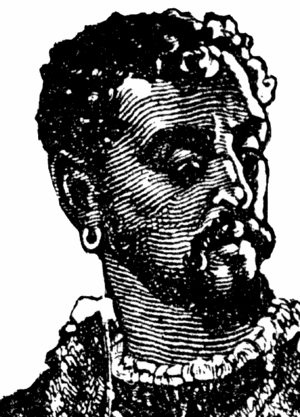Issues of race are present in many of Shakespeare’s plays. Racial difference is a “central” issue in several of his works, most notably Othello, The Merchant of Venice, and The Tempest (Bennett 209). Much of the debate about this issue has centered on the character of Caliban in The Tempest. Some modern critics see him as representative of the larger concerns of British Colonialism present during the birth of the British Empire, connecting him to the larger, more nebulous concept of the “racial other.” In her book Things of Darkness: Economies of Race and Gender in Early Modern England, Kim F. Hall states:
The text itself locates Caliban on one side of a binarism in Prospero’s final pronouncement on Caliban, “this thing of darkness I Acknowledge mine,” (5.1.275-276) and in clearly marking him as a slave who is associated with darkness and dirt: “thou earth” (1.2.314). Caliban functions as a “thing of darkness” against which a European social order is tested and proved (142)
This interpretation is indeed quite valid, even compelling, but is not the only possible way to view the character. After careful examination of several accounts contained within Richard Hakluyt’s Voyages and Discoveries, a simpler possibility begins to emerge. The circumstances of Caliban’s parentage, specifically the fact that his mother was exiled from Algiers and dropped on the island by sailors “suggests that Caliban himself must be considered as North African” (Lie 26) and as such can be seen as a stand in for all dark-skinned foreign peoples. Caliban is a reflection, and in some ways even a caricature, of late 16th and early 17th century British attitudes and misguided beliefs about the native peoples present in less-civilized parts of the world.
Descriptions of native peoples within Hakluyt’s volume seem to focus disproportionately on their nakedness and seeming physical prowess. In the account of the 1564 voyage of John Hawkins, upon arriving in Africa, the natives are described as “tawny, having long hair without any apparel, saving before their privy members” (Hakluyt 105). Four days later, another group of Africans is described, “these people are all black, and are called negroes, without any apparel, saving before their privities: of stature goodly men” (Hakluyt 106). The voyage was interested in the capture of slaves, consequently the assessment of the natives as “goodly men” was most likely a reference to their physical prowess rather than their polite nature. Later, near “Cumana,” they encounter another group of natives described as, “of colour tawny like an olive, having every one of them both men and women hair all black” (Hakluyt 107). Again, the majority of the description of the people focuses on their dress, or lack thereof. “They go all naked, the men covering no part of their body but their yard, upon the which they wear a gourd or piece of cane, made fast with a thread about their loins, leaving the other parts of their members uncovered, whereof they take no shame” (Hakluyt 108).
This obvious focus on the dress and nakedness of the natives encountered seems to belie an admiration of their physical prowess. These people were seen as savage, powerful, and lacking in the restraint and “shame” present in civilized society of the day. These views contributed to a vision of them both as curiosities and as potential sexual predators. The focus on the barely-covered loins of the men seems to indicate a fear and fascination with them as sexual objects, free of the constraints of society and capable of acting on impulse at any minute. The long black hair described would be seen as both exotic and a symbol of freedom. The English seem to regard the natives as curiosities, while simultaneously fearing the base, savage aspects of humanity they appear to embody.
In the play, Caliban embodies this fear through his attempted rape of Miranda and his desire to impregnate her with “Calibans” (1.2.416-421). For the people of Shakespeare’s time, judging by the evidence present in Hakluyt’s volumes, this would have been an accurate portrayal of the behavior of a savage native of an island wilderness. Shakespeare plays on this fear by including mention of this past incident and Caliban’s consequent fall from favor with Prospero because of it, no member of his audience would have believed an unrestrained native such as Caliban able to control his sexual impulses in the presence of a nubile, young white woman such as Miranda.
Another common characterization of natives in Voyages and Discoveries is of them as easily deceived, allured, and consequently subjugated. In Sebastian Cabot’s “Ordinances for the direction of the intended voyage for Cathay,” he advises that the natives be considered for “how they may be used” (Hakluyt 57). He says they should be allured or taken to be brought aboard ship so that the English can learn about the natives. “The person so taken, to be well entertained, used and appareled,” actually suggests that any native brought aboard ship would be easily mesmerized by English entertainments and clothing, his advice is to then convince their newly-indoctrinated captive to convince his people to come near (Hakluyt 57). One especially telling piece of advice then follows, “and if the person taken may be made drunk with your beer, or wine, you shall know the secrets of his heart” (Hakluyt 58). The English sense of superiority is so prevalent he actually feels it necessary to caution the sailors not to ridicule the natives (Hakluyt 58). Cabot advises the use of music played on drums or other instruments as a means of alluring the natives if need be (Hakluyt 58). When it comes to actual combat, the Hawkins account assures its reader of the prowess of the English, “whereas if five or six [English] had been together, they had been able, as their companions did, to give the overthrow to 40 of them” (Hakluyt 106).
So much of Cabot’s advice is literally present in The Tempest it’s almost as if Shakespeare was reading the list as he wrote the play. Prospero’s robe, as a symbol of his power, could be interpreted as representative of the power fine apparel is said to hold over native peoples. Caliban is “used” as Prospero’s servant and made to do all the “heavy lifting” as it were, constantly gathering firewood and the like (1.2.440). Caliban seems to be mesmerized by the manifestation of Prospero’s power, believing him more powerful than Setebos, the god of his mother Sycorax, despite the fact that Prospero seems to be able to actually do little more than deliver physical pain to him (1.2.440-450). When Caliban hears Stephano singing, he reacts strongly, fearing the power of the song (2.2.65). Then, as Cabot suggests, Stephano actually gives Caliban wine, enough to make him drunk, and the combination of Stephano’s “unearthly” alcohol (2.2.130) and singing leads Caliban to declare Stephano “a brave god [who] bears celestial liquor” (2.2.121). Caliban is completely mesmerized, just as any English citizen familiar with contemporary descriptions of native peoples encountered on sea voyages would expect. Trinculo eventually declares Caliban a “very weak monster” not worthy of his fear (2.2.150-153), reflecting the English fantasy that all uncivilized peoples were ignorant savages easily subjugated by the guile of the civilized English. Caliban embodies every stereotype that the people of the time would have come to expect, it’s doubtful that this was accidental on Shakespeare’s part.
Another common way of characterizing the natives in the narratives present in Hakluyt’s collection is as treacherous, bestial, tricksters. This is a bit ironic, considering they’re often made to seem stupid at the same time. Cabot advises sailors to stay close to their ships, avoid provoking the natives, remain wary of ambushes and keep weapons close at all times (Hakluyt 58). He makes special mention of “people that can swim in the sea, havens, and rivers, naked, having bows and shafts, coveting to draw nigh your ships” (Hakluyt 58) and attack, so that they can eat the bodies of those slain. The record of the Hawkins voyage contains an account of a caravel, “set upon by the inhabitants, who cut their cable in the hawser, whereby they were driven ashore, and so taken by them, and eaten” (Hakluyt 107). The matter-of-fact way the incident is reported makes it seem like an all-too-common occurrence. Consequently, English people of the time would probably have believed that native peoples frequently engaged in cannibalism.
Caliban’s name is derivative of the word “cannibal.” Trinculo initially comes across Caliban and says, “what have we here, a man or a fish? Dead or alive? A fish, he smells like a fish” (2.2.26-28). Later, Caliban convinces Stephano and Trinculo to sneak up on Prospero while he’s asleep (3.2.67-68), and when the three conspirators finally arrive to hatch their plan, they’re all soaking wet (4.1.216). The parallels to the Hakluyt accounts are amazing. Like the savages that swim up to unguarded ships in the middle of the night, Caliban plans to surreptitiously attack Prospero, and is wet when he arrives to do so. The natives attack to kill and eat the sailors and Caliban’s name is meant to invoke the word “cannibal.” The description of the dangerous natives swimming silently up to the anchored ship portrays them in a bestial, fish-like manner. Caliban is frequently described as having similar characteristics to a fish. Again, it seems unlikely that these similarities are mere coincidence. They must in some way reflect the popular conception of native peoples of the time.
Strong similarities also exist between the account of William Hawkins’ journey to Brazil and consequent return to Britain with a Brazilian king who was basically placed on display and gawked at by the King himself (Hakluyt 51-52) and Trinculo’s compulsion to “tame” Caliban and take him home to put on display so that Trinculo might profit from those who would pay to see him (2.2.30-34). Trinculo even goes so far as to make a direct comparison between Caliban and a “dead Indian.”
An impressive number of similarities exist between Shakespeare’s characterization of Caliban and accounts of actual sea voyages of the time. Many aspects mentioned in the writings about various encounters with native peoples all over the world make their way into the play through him. Parallels between the focus on the dress and implied sexual danger of various dark-skinned people encountered by English sailors and Caliban’s attempted rape of Miranda become obvious when the accounts and the play are placed side by side. Striking similarities between advice given by Cabot and actual tactics employed by Stephano and Trinculo in the play exist as well. The treacherous, deceitful nature of the natives expressed in the writings collected by Hakluyt is echoed in the plot of Caliban against Prospero, as is the concept of the racially different as a potential spectacle. The fact that such similar events occur in accounts of actual dealings with natives at the time and on the stages of London suggests that both reflect the pervasive ideology of the day. The character of Caliban, contrary to much scholarly thought, may not have been intended as a commentary on English racism and subjugation of natives, but rather merely reflected widely-held feelings and misconceptions of the time about the strange people encountered by sailors abroad.
Bennett, Andrew and Royle, Nicholas. Introduction to Literature, Criticism and Theory.
Harlow: Pearson Longman, 2004.
Hakluyt, Richard. Voyages and Discoveries. London: Penguin Books, 1972.
Hall, Kim F. Things of Darkness: Economies of Race and Gender in Early Modern
England. Ithaca: Cornell University Press, 1996.
Lie, Nadia, Haen, Theo D. Constellation Caliban: Figurations of a Character. Rodopi BV
Editions, 1997.
Shakespeare, William. The Tempest. New York: Washington Square Press: 2004.




